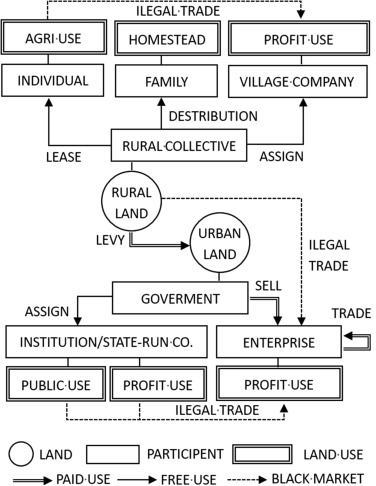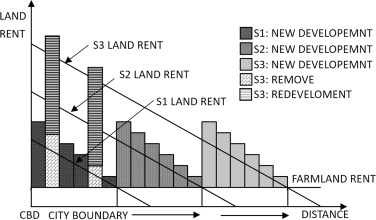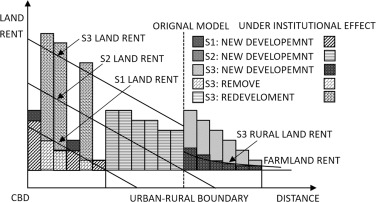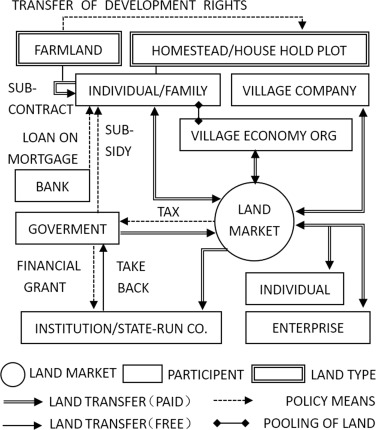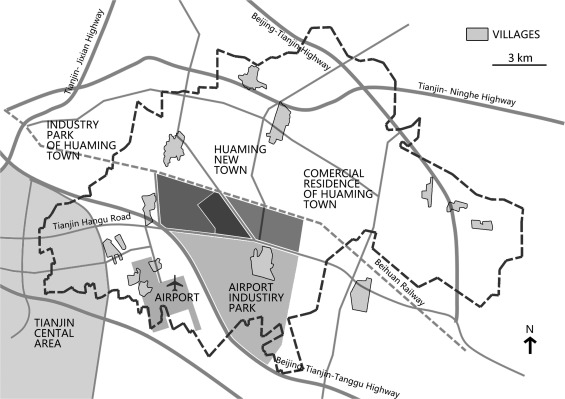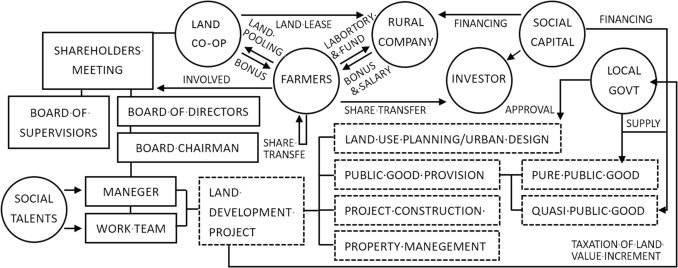Abstract
In China, the urban–rural dual structure of land market has resulted in urban sprawl caused by industrial diffusion. Urban sprawl disintegrated agricultural communities in suburbs, thereby increasing the unemployment rate among farmers who lost their lands. To address this problem, the Chinese government proposed a reform program to analyze the monopoly of the government in the land market and guarantee the property rights of farmers.
This study analyzed the connection between land market mechanism and suburban space formation. Results concluded that the current land transfer system caused industrial urban sprawl, and the reform program may promote the urban sprawl of population. Two typical models of rural land development were studied. A model called land cooperatives based on land pooling joint stock system was proposed to build a compact and sustainable suburban space.
Keywords
Land institution ; Suburban space ; Urban sprawl ; Land cooperatives
1. Introduction
1.1. Background
Since the 1980s, China׳s economy has experienced rapid development with fast urbanization. During urbanization, the input of land resources functions as one of the key driving factors.
According to China׳s Constitution, urban land is state-owned and rural land is owned by the village collective. Furthermore, rural land can be requisitioned by the government for public interest. In eastern China, urban land is almost exhausted, so local authorities have begun to abuse the power of land requisition. They mostly gain the land of villages without fair compensation but sold at the market price.
In the last decade, the wave of economic development zone construction in suburban areas, satellite cities, and campus cities spread across China. However, the density of these newly urbanized districts is relatively low. A study with 160 national economic development zones in China showed that the average building coverage ratio is 13.91%, and the average plot ration is only 0.43 (Pan, 2005 ).
Except for the spatial effect, farmers within the area of urban expansion have to adapt to a new lifestyle without farmland to become citizens. This upheaval can cause many social problems, such as unemployment and crime, which are also consequences of the disintegration of traditional communities.
The Chinese Central Government found that urbanization has encroached the interests of farmers, and a reform program is currently on the agenda to ensure the property rights of farmers. This radical change will have a far-reaching influence on suburban space in China.
1.2. Related work
With regard to Chinese village community research, Fei Xiaotong and Huang Zongzhi perceived Chinese villages as comprehensible social and economic community units. In recent years, some scholars studied those villages involved in passive or spontaneous industrialization and urbanization, and they reported the concept of village community reconstitution (Wang and Yan, 1990 ; Zhe and Chen, 2000 ; Lan, 2005 ; Li, 2010 ). Zhou (1995) considered the structural transition of Chinese villages as a result of studying the allocation of residual rights of rural land. Both Yang (2005) and Dong and Ren (2009) summarized the current patterns of rural land transfer and evaluated their efficiency. They believed that land pooling and market agency are preferable choices for rural land transfer. In the field of Chinese urban sprawl research, Hong and Zhang (2012) systematically studied the institutional factors that caused the overexpansion of Chinese cities. Li and Qu (2012) interconnected the increment of China׳s GDP and the growth of urban built-up area and proposed a positive correlation between them.
Since the implementation of the reform program, no research has compared the spatial and social effects of the current and anticipated land transfer institution. This paper proposes a mechanism of rural land development based on the comparative study of practical models to build quality and healthy urban–rural space under land transfer reform.
2. Current land market institution and its spatial effect
2.1. Dynamic model of urban density determination
In the mathematically abstracted single-center city, indicators such as price of houses, density of capital, price of land, and density of population decline with increasing distance to the city center (Ding, 2005 ). When the development of the single-center city is divided into three stages, an updated model can be achieved (Figure 2 ).
In the second stage, the land near the boundary of the primarily developed area is expensive, so it has a high density. In the third stage, the development of an external area follows the mode of the second stage. Redevelopment becomes profitable with increasing land price in the city center (Ding, 2005 ).
2.2. Current land transfer market system
Figure 1 illustrates the operational mechanism of the current land circulation system. The local government is the only land supplier, so rural land must be levied before it is sold to enterprises or assigned to state-run institutions or companies. In the urban land market, state-run enterprises and institutions may obtain land by distribution, whereas non-public economic organizations must pay for it.
|
|
|
Figure 1. Dual-structural Land Transfer System. |
Within villages, the legal land market does not exist. Farmers are allowed to subcontract farmland to another community member or an agricultural organization, but none of them can change the land use.
The austerity policy of land supply increases the price of urban land and gives birth to the black market of land transfer. Illegal land trading shows the eagerness of landowners to obtain profit from their usufruct. Local authorities usually ignore black market transactions so that the interests of both sides can hardly be admitted in court.
The main character of the current land transfer market system is the government monopoly of primary land market. Rather than citizens, farmers are actual land managers, but they are excluded from land transfer activities. Even as the legal land owner, the village collective is forbidden to sell its land. Such land institution is decisive in the shaping of current suburban space.
2.3. Model modification under institutional constraints
The model can be modified, considering the effect of land supply institute (Figure 3 ). Taking advantage of the double-track price system of urban land supply, institutions can gain urban land from the local government for free (Figure 1 ); therefore, the density of institutionally used land, such as government office, state-run enterprise, university, and military organization, is considerably lower than the average level of commercial development. Consequently, the total density of the first stage of development is lower than that of the dynamic model.
|
|
|
Figure 2. Dynamic model of urban density determination (Ding, 2005 ). |
|
|
|
Figure 3. Dynamic model of urban density determination with Instit. |
During the second stage, the growth of city population increases the house demand. Land is not fully developed in the first stage, so the investors use more parcels of land. However, the limitation of rural land transfer reduces the amount of available land. Therefore, the city developers should increase density to satisfy the growing house demand. In distant areas, house price is higher than its actual value because of the lack of infrastructure and public service.
In the third stage, the low-density city center fully occupied with institutions is attractive for developers. As land price continues to increase, many institutions move to rural areas so that the city center can be redeveloped. These institutions, together with new industrial investors, use more rural lands because of the low price. Such use of rural land is one of the main characteristics of suburban space in China. Many scholars used the conception of urban sprawl to describe this phenomenon.
3. Reform program and its anticipated spatial effect
3.1. Operational mechanism of unified urban–rural land market
Figure 4 illustrates the operational mechanism of unified urban–rural land market. The role of the government will be changed from the controller of land transfer to the land market regulator. Compared with the current system (Figure 1 ), most land transfer activities will be conducted by market economy. Farmers shall be able to use their land fully.
|
|
|
Figure 4. Unified land transfer system. |
Furthermore, a set of policy means will be applied to compensate for the defects of market operation, thereby ensuring the realization of public interest and social equity.
3.2. Anticipated spatial effect of the reform program
3.2.1. Motivating factors of urban sprawl
The popularization of private cars and television sets, development of main roads, and preference of courtyard houses caused the urban sprawl in the United States. The desire of citizens to live in houses with intimate courtyards and good natural environment is restrained by monopolized land supply.
However, when the transfer of rural family homestead is permitted, citizens with strong purchasing power and who live in overdeveloped high-rise collective houses, specifically those without adequate public product supply (Figure 3 , Stage 2), will urgently escape from the city and spread to the vast countryside.
3.2.2. Inhibitory factors of urban sprawl
If the property right of each individual farmer is well protected, the current method of land requisition will occupy a large amount of time to reach an agreement with each land owner. Land transferor can be paid directly by selling homestead to an individual buyer; the buyer who wants more parcels of land will increase his/her bid. Therefore, high expense will restrain the current urban sprawl pattern.
Notably, the abolishment of a double-track price system will encourage institutions and state-run enterprises to fully use the land they paid with a financial grant.
The reduced supply of large-scale rural land will encourage investors to use a large amount of capital and less land, thereby making the development of suburbs compact.
3.2.3. Comprehensive evaluation
The reform program means that future suburban rural land development will be driven by individual consumption rather than industry investment. Trading of single homestead will be allowed to realize the property rights, but fragmented land supply should be limited for the intensive use of land resources (Table 1 ).
| Land user | Motivating factors | Inhibitory factors |
|---|---|---|
| Urban middle class families | Fragmented land supply | Unacquainted Local Community |
| Better Environment | Lack of Public Good | |
| Industrial Diffusion | Limited Construction Land Stock | |
| Cheap Commuting Cost | ||
| Lower Crime Rate | ||
| The development of Internet | ||
| Institutions | Higher Land Price in City Center | Fragmented Land Supply |
| The Abolishment of Double Track Price System | ||
| Enterprises | Preferential Policies Provided by Govt | |
| Higher Rural Land Price | ||
| Urban Developers | Cheaper Laboratory | Longer Developing Cycle |
4. Comparative study of two innovative approaches of urbanization: Huaming and Nanhai models
4.1. Government-led Suburb development: Huaming model
4.1.1. Introduction
In recent years, many Chinese local authorities began to innovate rural land transfer pattern. The most influential method was the Exchange Homestead for House policy designed and carried out by Tianjin in the project of Huaming New Town. Similar practice was performed in Jiulongpo, Chongqing, Jiaxing, and Zhejiang.
Exchange Homestead for House means farmers can give up their property rights of homestead. In return, they can move into apartments in a new town. Until the end of 2008, over 100,000 farmers moved into new towns.
The policy initially aimed to conglomerate the settlement of villagers mainly by heightening the density of residence so that saved land could be reclaimed or commercially developed. This paper deemed such an approach as government-led suburban development.
Huaming Town belongs to Dongli District, Tianjin. It is located to the east of Tianjin outer ring road and north of Tianjin Binhai international airport and its accessory industrial park. The Tianjin Hangu Road, which connects Tianjin downtown with Binhai New Area, is across Huaming Town area. These locational factors all promote land value (Figure 5 ).
|
|
|
Figure 5. Huaming new town project. |
4.1.2. Exchanging rules and supporting policies
During the implementation of the Exchanging Homestead for House policy, the houses rather than homestead were calculated for exchange. According to the detailed rules of the government, 1 m2 of a farmer׳s main house converts to equal floor space in Huaming new town, and 1 m2 of auxiliary house is equivalent to 0.5 m2 of floor space. The courtyard is not included. For example, considering a family with 1 mu (1 mu is approximately equal to 667 m2 ) homestead, on which a 60 m2 main house and 40 m2 accessory house are established, the family may obtain a set of 90 m2 apartment if they will move into a new town. If the apartment is more than 90 m2 , the family must pay for the extra area at market price.
The local government also made some policies to help farmers who lost their homestead. These policies included public production provision, social security provision, free occupational education, free technical training, and job recommendation.
4.1.3. Integrated evaluation of Huaming model
The volume ratio of Huaming new town is 0.75, which is lower than the average urban volume ratio (0.8–1.0). However, considering the condition that each village of Huaming town is to be developed separately, the Huaming new town is successive in compactness.
Farmers were the least to benefit after the calculation of gains and losses of the participants of such an experiment. The problem was the unbalanced land increment allocation. For example, in Guanzhuang village, farmers owned a total of 142.8 ha homestead land, which was about 749 m2 per family. However, each family only gained 75 m2 new house, which was worth 300,000 yuan at market price. According to official data, the average income of land transfer was 15 million yuan per hectare, which demonstrated that each homestead of Guanzhuang village families was worth approximately 1.2 million. More than 75% of land increment was taken by the local government. Farmers did not only have to bear with direct economic loss, but they could hardly engage in agricultural production because of residential migration. The change in career created difficulty for farmers to obtain a job after moving into new towns.
Urbanization, specifically the non-agriculturalization of farmers, is a long-term event in most countries. The transformation from farmers to citizens must be based on the promotion of education level. In this perspective, urbanization should be driven by farmers themselves because they are free to choose their own way of life.
4.2. Village collective-led suburb development: Nanhai model
4.2.1. Introduction
Cooperative economy has a deep foundation in China׳s countryside after 1970. Agricultural production and collective-run industry both function well in such an economy. In the case of Nanhai, cooperative economy was introduced into land development.
Nanhai is a district of Foshan City, and it is located near Pearl River Delta. It has a population of 2.6 million. With its location advantage of being adjacent to Hong Kong, Macao, and Guangzhou, agricultural land is continuously converted into industrial use.
Confronted with the irresistible temptation of developing industry, the local government permitted village collectives to build factory buildings by themselves to attract the establishment of enterprises. At the time, the local government did not have sufficient funds to support land levelling and infrastructure construction. In 1992, a land-based joint-stock system was established. The village community divided the collective-owned assets and land into pieces as shares that comprised a new joint-stock organization. The organization rents the land directly to investors or constructed workshops. The farmers, as shareholders, may obtain the profit through bonus distribution. This paper deemed such an approach as village collective-led suburban development.
4.2.2. Rules of benefit distribution and implementation
Under the policy, after paying taxes and fees, covering the budget deficit, taking 10% as the welfare fund, 51% of the remaining net income should be preserved as developing fund, and the other 49% will be distributed as bonus.
According to data of the second Domestic Land Investigation (2007–2009), Nanhai district owns about 53,166 ha of construction land, of which 71% (37,700 ha) is owned by the village collective. Among the collective-owned construction land, farmers’ homestead land is about 11,333 ha, and construction for industrial use is about 25,965 ha.
In 2012, the running of construction land created an income of 3 billion yuan. The distributed profit was about 2.67 billion yuan, and the average was 3516 yuan per shareholder (Development Research Center of the State Council, 2014). The local government also benefitted from collective-run property management via tax collection.
4.2.3. Integrated evaluation of Nanhai model
The Nanhai model demonstrated that development driven by the village collective and supported by the local government benefits both the farmers and government. First, the model saves the cost of land consolidation commonly carried out by the government before land transfer, which makes land rent more competitive than traditional levied rural land.
However, the Nanhai model is challenged by its defective organizational structure. As a land management entity, the economic organization is closely related to village commission, which is usually dominated by a few village elites. The decision-making process, including the disposition of resources, remains unclear. Similar to common collective-run companies, the property right of Nanhai village economics is ambiguous, and the identification of shareholders strictly overlaps with that of community members.
The shareholders of each land pooling cooperatives are relatively fixed; therefore, the optimal allocation of resources in a large scale becomes impossible. The homogeneous competition of the manufacturing industry within Nanhai area is serious, and land development is scattered.
4.3. Comparison of Huaming and Nanhai models
A comparison of Huaming and Nanhai models is shown in Table 2 . The Huaming model cares more about efficiency but less about social equity, whereas the Nanhai model is more equitable for farmers but less efficient.
| Item | Huaming model | Nanhai model |
|---|---|---|
| Location | Suburb of Tianjin City | Suburb of Foshan City |
| Time | Since 2005 | Since 1992 |
| Way of land transfer | Permanent transfer | Term lease |
| Subject of development | Govt established company | Village collective-run company |
| The role of local govt | Developer | Policy Maker |
| Way of Investment | Bank loans | Fund raising |
| Density of development | High | Low |
| Speed of development | Fast | Slow |
| Benefit of farmers | Lump-sum compensation | Corporate dividends |
| Benefit of local govt | Land transaction fees | Taxes |
| Existence of cooperative economy before/after | Yes/No | Yes/Yes |
| Identification of natives before/after | Rural/Urban household registration | Rural/Rural household registration |
| Preservation of agriculture | No | Yes |
The key factors of land development are capital and technology. Government-established companies can obtain bank loans and assign plans easily. Large-scale land development is unreasonable for village collective-run companies, because the cooperative economy units do not merge and land arrangement only occurs within each village community.
5. Mechanism design of land cooperative model
5.1. Introduction of Land Cooperative (Land Co-op)
Efficient and sustainable land development in suburban areas needs a specific organization. Within the current structure, the legal representative subject is the Village Committee. However, as the basic power institution, the Village Committee is affected by high-level government. In most occasions, the committee can hardly speak for farmers.
The separation of administrative and economic functions is one of the most important contents in the reform of Chinese village organization. An independent economic organization is essential in land transfer and other economic activities.
The Land Co-op mentioned in the title is an organization that aims to build a compact suburban space on the premise that farmers keep their land ownership.
5.2. Operation mechanism of Land Co-op
Land Co-op is organized by land pooling such that a voluntary villager can abandon his/her right of free land development and become a shareholder of Land Co-op. Shares can be transferred; if one wants to quit, he or she may obtain an equal amount of land elsewhere.
This concentration of land management right can compensate for the deficiency of scattered development and form an agglomeration effect. The physical right of land is transformed to nonfigurative contractual right through land pooling, thereby restricting fragmented land transfer and use.
To address the deficiencies of the Nanhai model, the Land Co-op model emphasizes the division of ownership and management (Figure 6 ). Land development is more complicated than traditional economic activities, so Land Co-op must introduce advanced talent and experience. Furthermore, the diversification of investment subjects will be helpful to solve the financing problem of village construction. Investors can gain the development right through purchase of stocks. When one specific investor possesses not less than 51% of total stocks, he/she can dominate the development.
|
|
|
Figure 6. Operation mechanism of Land Co-op. |
Different from the old pattern, such a status is under the supervision of other shareholders. Land Co-op should focus on land development affairs, so the relationship between Co-op and collective-run companies is critical.
Land Co-op is a land pooling-based joint stock system. Land, as a production factor, should withdraw from corporate economies. Subsequently, Land Co-op may rent out land to collective-run companies.
In the implementation of land development project, the manager of Land Co-op and his/her work team will be the protagonist. First, they must prepare a land use plan and urban design blue print; such a process should be based on public participation. The scheme must be approved in the shareholders’ meeting and pass government review. Second, the manager should raise funds for infrastructure construction; the key factor of this step is the discrimination of pure public good and quasi-public good. With marginal utility, the pure public good, such as streets and municipal facilities, should be provided by the government to achieve optimal resource allocation. The government may pay the cost through transfer payment or bank loan using tax revenue as collateral. The financial expenditure of the government can be composed of property tax collection. In the case of Huaming New Town, the local government uses the profit of land trading and development for infrastructural investment, which is inappropriate in terms of public good provision. Another part of public good is quasi-public good, which can be provided by both government and social capital.
For profit distribution based on the Land Co-op model, the land value increment and operating income will be partly accounted to the government, management group, and land owner.
5.3. Social reconstitution of village community under Land Co-op
This paper considers social reconstitution of village community as a result of economic organizational relationship transformation.
The local knowledge is a set of surviving principles under a specific local condition. The reform program attempts to ensure farmers’ independence and completeness of property right, which will gradually transform them into modern citizens.
In the Land Co-op model, the openness of a personnel system and financing system will create a strong connection between villages and external environment. Long-term land development will provide sufficient time for the villagers to adapt to the modern interpersonal relationship based on a contract.
5.4. New role of government under Land Co-op model
5.4.1. Lawmaking and policy support
The effective running of Land Co-op requires clear property right identification and registration, a normative land transfer market, and popularization of property right knowledge. Consequently, the central government should establish a set of laws and regulations to guarantee the implementation of the reform program.
Moreover, the local government should establish a series of policies that can protect the interest of rural land owners to encourage spontaneous land development with compactness.
5.4.2. Taxation as regulation measure
Property tax is a promising solution for the local government to share the increment of land value brought by pure public good supply after land reform. Property tax can also restrain low-density development, because the increase in population density can lower average tax burden.
Low-density development causes negative external effects. The government may collect sprawl tax to internalize externalities and control the fragmented land development.
5.4.3. Standard of rural planning in suburban area as regulation measure
Land Co-op is created for lucrative purposes, and its land use plan may ignore public interest in a large scale. Therefore, a standard for rural planning in suburban areas and a related evaluation system should be established. A development project must satisfy the standard requirement and pass relative evaluation before execution.
6. Conclusion
The current land transfer market system resulted in industrial urban sprawl. The land transfer reform program can effectively restrain the use of rural land by institutions and enterprises, but it may promote population urban sprawl.
The Exchange Homestead for House and other similar policies (represented by the Huaming model) successfully realized the compact development of a suburban area but deprived the farmers’ right of sustainable land use. The land pooling cooperative strategy (represented by the Nanhai model) successfully ensured the property rights of farmers but remained inefficient and short-sighted.
The design of Land Co-op is conducive to the reconstitution of traditional community, economically and socially. Such a mechanism can possibly avoid population urban sprawl and build a compact and sustainable suburban space.
References
- Ding, 2005 C.R. Ding; Mechanism of urban density determination: static and dynamic models; Urban Plan. Overseas, 20 (4) (2005), pp. 7–10
- Dong and Ren, 2009 G.L. Dong, J.P. Ren; Land transfer mode and economic performance under the property agency analysis; Sociol. Stud. (1) (2009), pp. 25–63
- Hong and Zhang, 2012 S.J. Hong, J.X. Zhang; Mechanism and Control of Urban Sprawl: Based on Economy and Institution Analysis, SEU Press, Nanjing (2012)
- Lan, 2005 Y.Y. Lan; A Village in City, SDX Joint Publishing Company, Beijing (2005)
- Li, 2010 P.L. Li; End of Village: The Story of Yangcheng Village, The Commercial Press, Beijing (2010)
- Li and Qu, 2012 X.S. Li, F.T. Qu; Economic development and urban sprawl: the logistic curve hypothesis and its verification; J. Nat. Resour. (5) (2012), pp. 713–722
- Pan, 2005 Z.Q. Pan; Propel the efficient use of land and build up conservation-oriented society; Guangming Dly. (2005) 2005-12-14
- Wang and Yan, 1990 H.S. Wang, X.F. Yan; Industrialization and social differentiation: Chinese rural social construction change since reform and opening; Rural Econ. Soc. (4) (1990), pp. 1–14
- Yang, 2005 D.C. Yang; Choice of models of Chinese rural land transfer; Mod. Econ. Res. (12) (2005), pp. 49–52
- Zhe and Chen, 2000 X.Y. Zhe, Y.Y. Chen; A Practice of Community: The Development of Super Village, Zhejiang People׳s Publishing House, Hangzhou (2000)
- Zhou, 1995 Q.R. Zhou; Chinese rural reform: change of relationship between state and ownership; Manag. World (3) (1995), pp. 178–189
Document information
Published on 12/05/17
Submitted on 12/05/17
Licence: Other
Share this document
Keywords
claim authorship
Are you one of the authors of this document?
